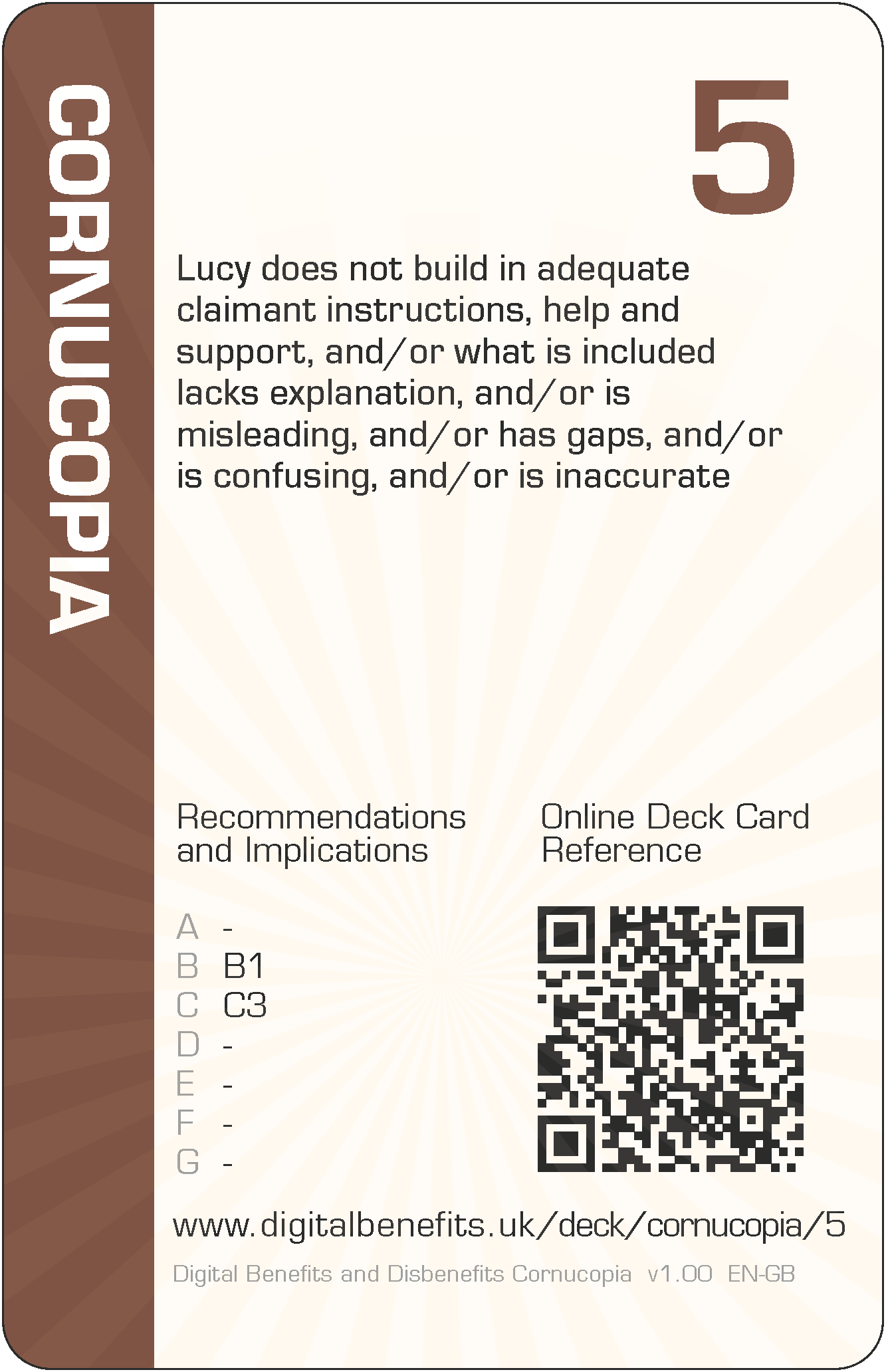Cornucopia 5 (CO-5) Card
DBD Cornucopia > Deck > Cornucopia > 5
Card Details - Five of Cornucopia
Abbreviation
CO-5
Card's focus
The focus of this card is instructions
Threat to claimants
Lucy does not build in adequate claimant instructions, help and support, and/or what is included lacks explanation, and/or is misleading, and/or has gaps, and/or is confusing, and/or is inaccurate

Threat to claimants
Lucy does not build in adequate claimant instructions, help and support, and/or what is included lacks explanation, and/or is misleading, and/or has gaps, and/or is confusing, and/or is inaccurate.
Some examples of how this threat could lead to harms (negative effects on claimants)
The design recommendations and implications relevant to the card are listed below in the next section, but even those can be somewhat abstract and difficult to think about during practical day-to-day implementation. Therefore, some example harms are provided to complement the more formal research outputs. These examples are unique per card, and are only published on these web pages (i.e. in no other project outputs).
- Claimants need additional knowledge to understand the correct meaning of questions (e.g. who are classed as dependents), so they provide inaccurate answers inadvertently which are identified later, delaying their claim
- Automated help outputs, such as from an AI chatbot, give invalid or outdated or incorrect information to claimants, who are just seeking to make and manage their claims honestly and accurately, leading to not claiming or being classed as ineligible when they are eligible, or being awarded a lower award than they should receive for their true circumstances
- Where warnings highlight how claiming can affect other benefits received, the warnings are not comprehensive, leaving claimants with the impression that they will not be affected
- Claimants are asked to tick a checkbox confirming they understand instructions, which is mandatory to proceed, but are driven by their immediate need to get financial help, so tick the checkbox regardless of their understanding
The examples are to help understand the threat on the card, not to suppress thinking and innovation. Incorporating these examples exactly, or closely matching ones, should be scored down when playing DBD Cornucopia as a game.
Applicable design recommendations and implications
These are reproduced here from Research Briefing N
Acknowledge claimants as people in digital design
- Prioritise claimants' interests over system efficiencies
All digital welfare design processes, methods and decision-making should prioritise claimants' needs to achieve best outcomes for individuals rather than system efficiencies. Organisational knowledge and resources should be utilised to this respect including intervening in advance to identify matters that affect claims or what claimants may have forgotten about.
Reduce claimants’ interaction burdens with digital welfare
- Provide full social protection services across wider interoperable channels
Ensure all service provision and modes of assistance (e.g., provision of advice, practical support and self-help guidance) are available through multiple interaction channels (e.g., telephone, web, mobile app) which are accessible to varying resources and capabilities (e.g., communication skills, equipment, language, physical and mental abilities). Permit the use and intermixing of channels without restriction. Consider providing on-demand synchronous interactions through digital as well as other channels.
General Notes
Card values (i.e. '5' for this card) are for game play and are not correlated with the severity of harm. This is because threats cannot be ranked directly since they can affect individuals in different ways due to situations and circumstances, or affect fewer or more claimants, or the harms can arise in claimants' support networks and wider society.
The threat description uses a person's name as the "attacker" (i.e. 'Lucy' for this card), which can be thought of someone involved with implementation. They could have any role which influence digitisation. So they could be a database administrator, or a copy writer, or a quality assurance specialist, etc, or all of these. Everyone could have some influence on the claimant threat described. The names were randomly selected from those currently most popular as given names for boys and girls (UK Office for National Statistics).
The example harms provided are drawn from the research data (which explored not only parts of existing services but also the effects of possible changes to those), from the author's own knowledge of web application development and testing, the author's own experience of helping citizens to claim Universal Credit (UC) and Personal Independence Payment (PIP), and from suggestions submitted by other people (make a suggestion). The threats and example harms do not necessarily exist in the current UC or PIP deployments or in ecosystems around those services, but they might well do.
All the cards in this Cornucopia suit are: 2 3 4 5 6 7 8 9 10 J Q K A
The other suits in the deck are: Scope, Architecture, Agency, Trust and Porosity (plus Jokers).
